PC 2 Assignment: Chronic and Complex Care Needs of Mrs. Mary Tonkin
VerifiedAdded on 2022/08/27
|17
|4561
|18
Report
AI Summary
This report examines the chronic and complex care needs of Mrs. Mary Tonkin, a 79-year-old patient with multiple health issues including type 2 diabetes, a history of strokes, and other chronic conditions. The report defines chronic and complex care, and argues that Mrs. Tonkin has complex care needs, specifically focusing on diabetes management, education, and emotional support as priority areas. It details how these needs can be met through a multidisciplinary approach in her home, involving diabetes specialist nurses, social workers, physiotherapists, and nutritionists. The role of the registered nurse in assessing, educating, and managing her care is highlighted. The report also identifies potential barriers to care, such as ageism and family dynamics, and addresses issues related to her medication. Finally, the report concludes by summarizing the key points and emphasizes the importance of providing comprehensive, patient-centered care to improve Mrs. Tonkin's quality of life and avoid hospitalization. The report emphasizes the importance of a therapeutic relationship with the patient and her family, and provides information on how to implement that relationship.
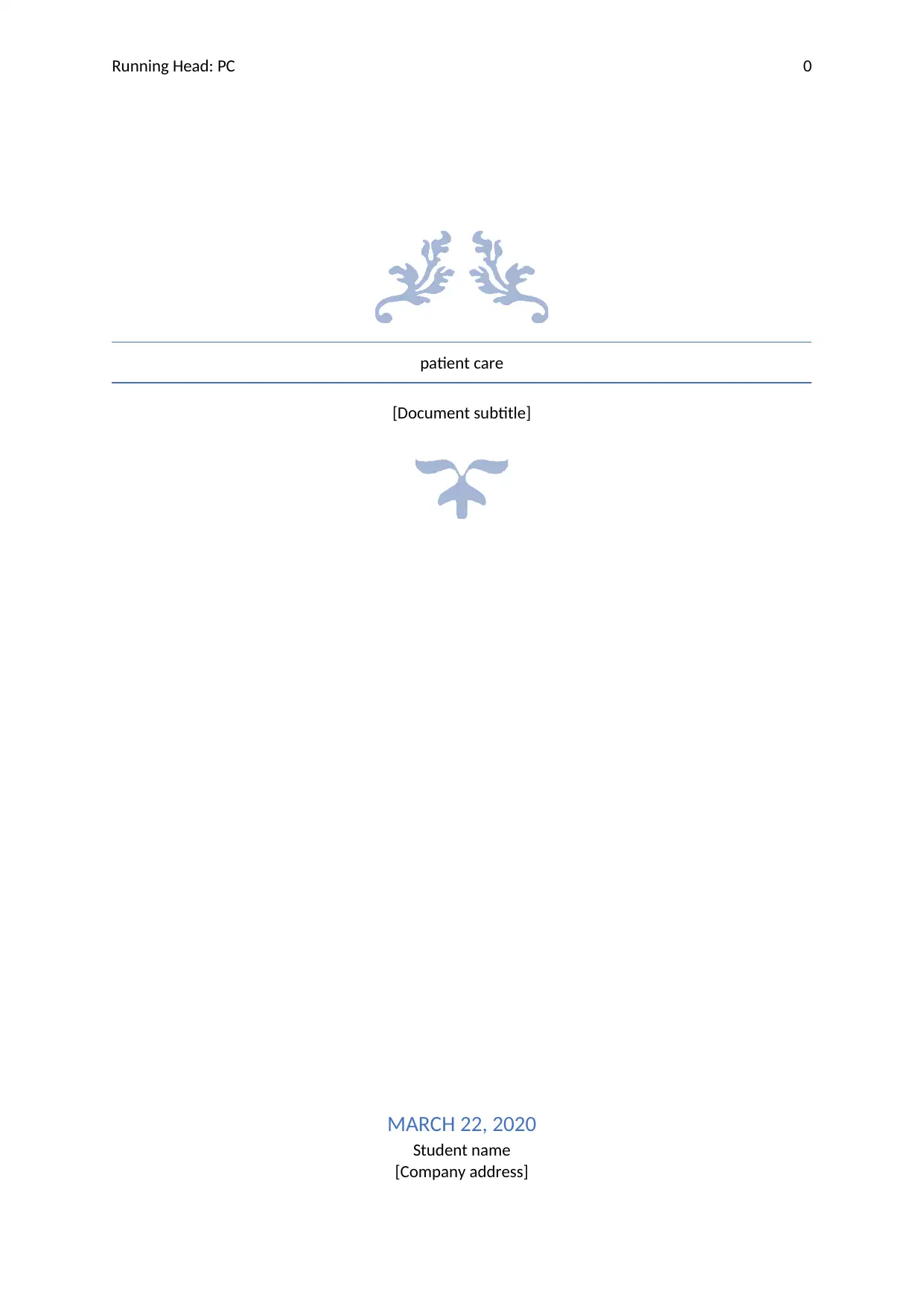
Running Head: PC 0
patient care
[Document subtitle]
MARCH 22, 2020
Student name
[Company address]
patient care
[Document subtitle]
MARCH 22, 2020
Student name
[Company address]
Paraphrase This Document
Need a fresh take? Get an instant paraphrase of this document with our AI Paraphraser
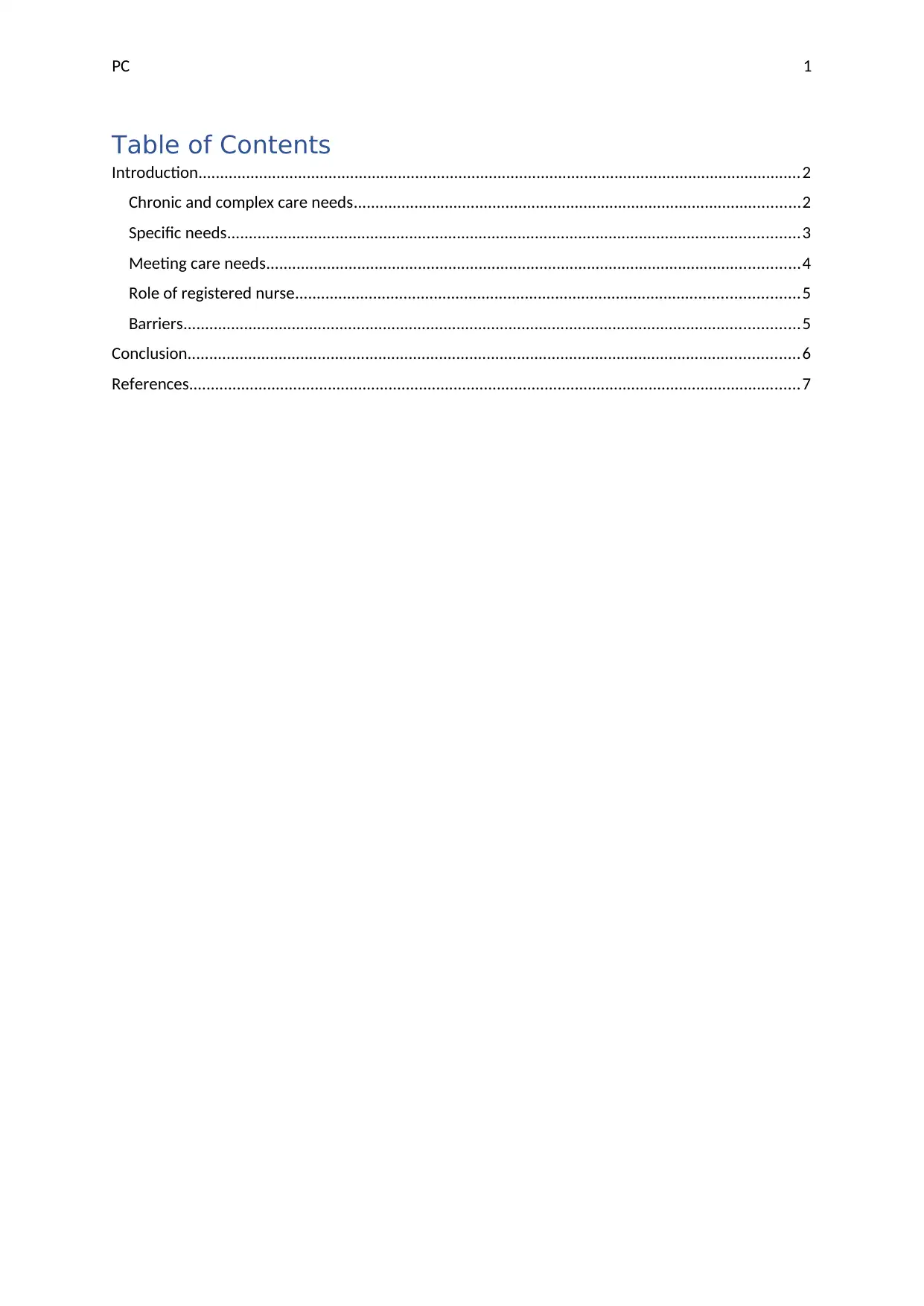
PC 1
Table of Contents
Introduction...........................................................................................................................................2
Chronic and complex care needs.......................................................................................................2
Specific needs....................................................................................................................................3
Meeting care needs...........................................................................................................................4
Role of registered nurse....................................................................................................................5
Barriers..............................................................................................................................................5
Conclusion.............................................................................................................................................6
References.............................................................................................................................................7
Table of Contents
Introduction...........................................................................................................................................2
Chronic and complex care needs.......................................................................................................2
Specific needs....................................................................................................................................3
Meeting care needs...........................................................................................................................4
Role of registered nurse....................................................................................................................5
Barriers..............................................................................................................................................5
Conclusion.............................................................................................................................................6
References.............................................................................................................................................7
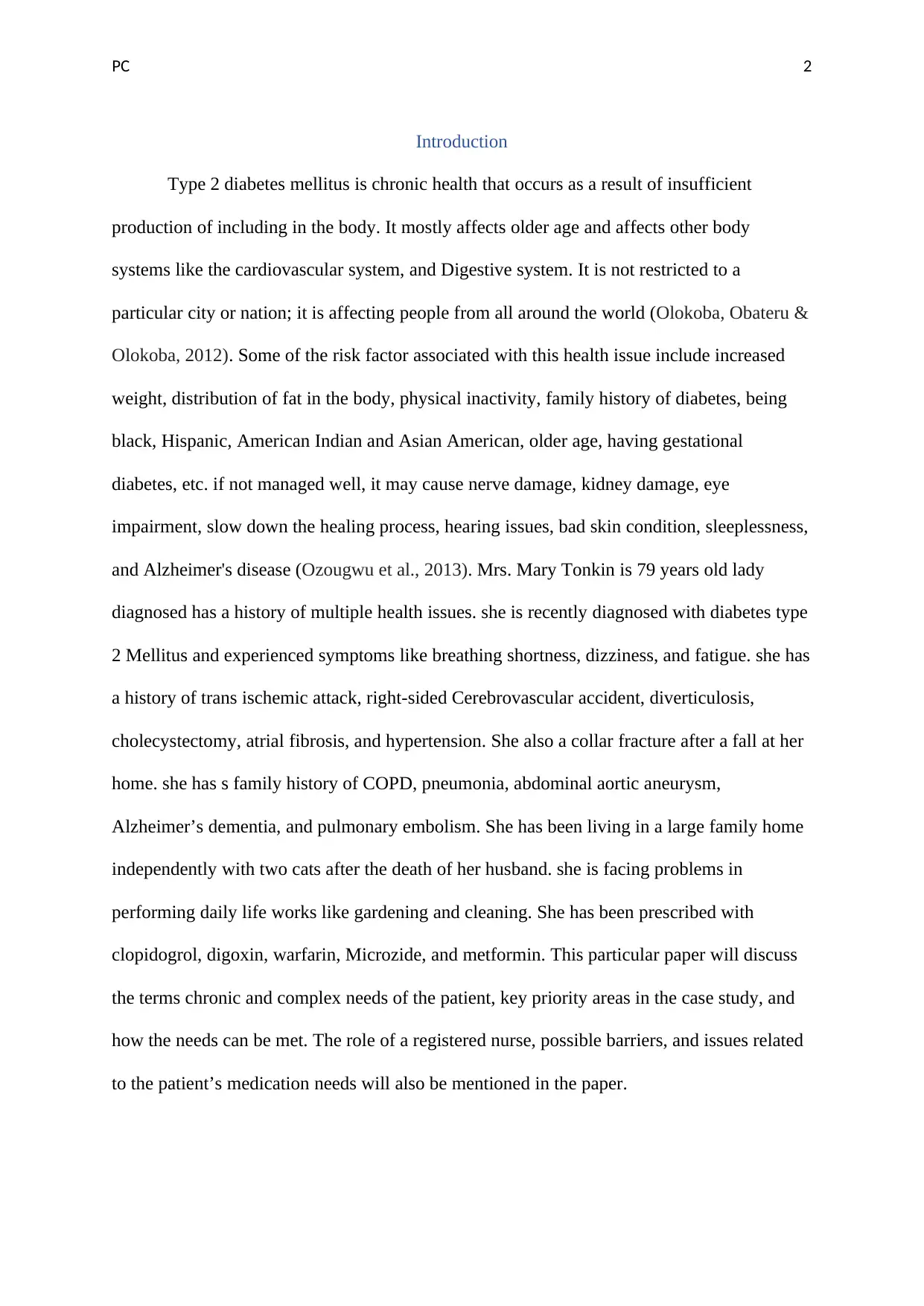
PC 2
Introduction
Type 2 diabetes mellitus is chronic health that occurs as a result of insufficient
production of including in the body. It mostly affects older age and affects other body
systems like the cardiovascular system, and Digestive system. It is not restricted to a
particular city or nation; it is affecting people from all around the world (Olokoba, Obateru &
Olokoba, 2012). Some of the risk factor associated with this health issue include increased
weight, distribution of fat in the body, physical inactivity, family history of diabetes, being
black, Hispanic, American Indian and Asian American, older age, having gestational
diabetes, etc. if not managed well, it may cause nerve damage, kidney damage, eye
impairment, slow down the healing process, hearing issues, bad skin condition, sleeplessness,
and Alzheimer's disease (Ozougwu et al., 2013). Mrs. Mary Tonkin is 79 years old lady
diagnosed has a history of multiple health issues. she is recently diagnosed with diabetes type
2 Mellitus and experienced symptoms like breathing shortness, dizziness, and fatigue. she has
a history of trans ischemic attack, right-sided Cerebrovascular accident, diverticulosis,
cholecystectomy, atrial fibrosis, and hypertension. She also a collar fracture after a fall at her
home. she has s family history of COPD, pneumonia, abdominal aortic aneurysm,
Alzheimer’s dementia, and pulmonary embolism. She has been living in a large family home
independently with two cats after the death of her husband. she is facing problems in
performing daily life works like gardening and cleaning. She has been prescribed with
clopidogrol, digoxin, warfarin, Microzide, and metformin. This particular paper will discuss
the terms chronic and complex needs of the patient, key priority areas in the case study, and
how the needs can be met. The role of a registered nurse, possible barriers, and issues related
to the patient’s medication needs will also be mentioned in the paper.
Introduction
Type 2 diabetes mellitus is chronic health that occurs as a result of insufficient
production of including in the body. It mostly affects older age and affects other body
systems like the cardiovascular system, and Digestive system. It is not restricted to a
particular city or nation; it is affecting people from all around the world (Olokoba, Obateru &
Olokoba, 2012). Some of the risk factor associated with this health issue include increased
weight, distribution of fat in the body, physical inactivity, family history of diabetes, being
black, Hispanic, American Indian and Asian American, older age, having gestational
diabetes, etc. if not managed well, it may cause nerve damage, kidney damage, eye
impairment, slow down the healing process, hearing issues, bad skin condition, sleeplessness,
and Alzheimer's disease (Ozougwu et al., 2013). Mrs. Mary Tonkin is 79 years old lady
diagnosed has a history of multiple health issues. she is recently diagnosed with diabetes type
2 Mellitus and experienced symptoms like breathing shortness, dizziness, and fatigue. she has
a history of trans ischemic attack, right-sided Cerebrovascular accident, diverticulosis,
cholecystectomy, atrial fibrosis, and hypertension. She also a collar fracture after a fall at her
home. she has s family history of COPD, pneumonia, abdominal aortic aneurysm,
Alzheimer’s dementia, and pulmonary embolism. She has been living in a large family home
independently with two cats after the death of her husband. she is facing problems in
performing daily life works like gardening and cleaning. She has been prescribed with
clopidogrol, digoxin, warfarin, Microzide, and metformin. This particular paper will discuss
the terms chronic and complex needs of the patient, key priority areas in the case study, and
how the needs can be met. The role of a registered nurse, possible barriers, and issues related
to the patient’s medication needs will also be mentioned in the paper.
⊘ This is a preview!⊘
Do you want full access?
Subscribe today to unlock all pages.

Trusted by 1+ million students worldwide
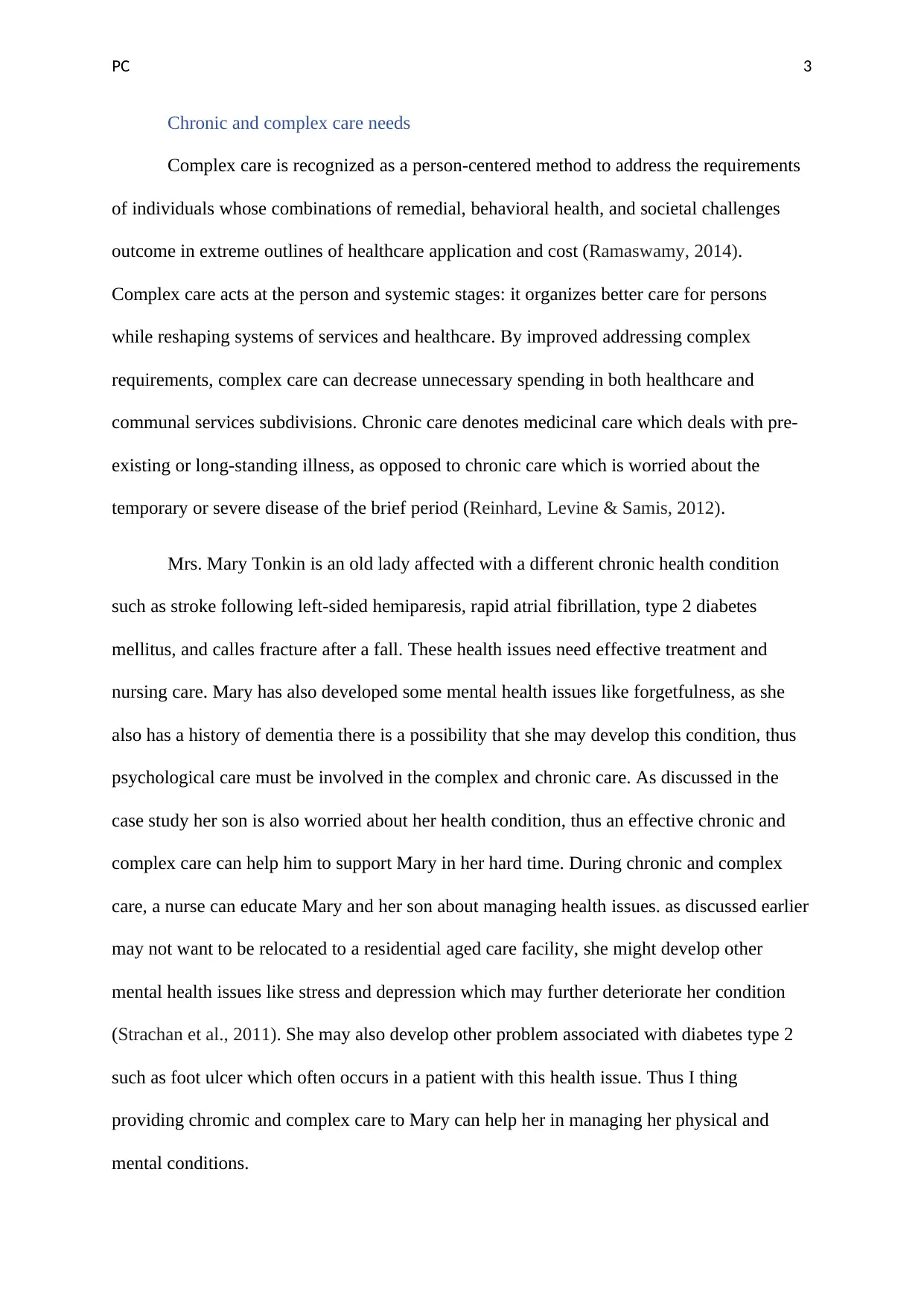
PC 3
Chronic and complex care needs
Complex care is recognized as a person-centered method to address the requirements
of individuals whose combinations of remedial, behavioral health, and societal challenges
outcome in extreme outlines of healthcare application and cost (Ramaswamy, 2014).
Complex care acts at the person and systemic stages: it organizes better care for persons
while reshaping systems of services and healthcare. By improved addressing complex
requirements, complex care can decrease unnecessary spending in both healthcare and
communal services subdivisions. Chronic care denotes medicinal care which deals with pre-
existing or long-standing illness, as opposed to chronic care which is worried about the
temporary or severe disease of the brief period (Reinhard, Levine & Samis, 2012).
Mrs. Mary Tonkin is an old lady affected with a different chronic health condition
such as stroke following left-sided hemiparesis, rapid atrial fibrillation, type 2 diabetes
mellitus, and calles fracture after a fall. These health issues need effective treatment and
nursing care. Mary has also developed some mental health issues like forgetfulness, as she
also has a history of dementia there is a possibility that she may develop this condition, thus
psychological care must be involved in the complex and chronic care. As discussed in the
case study her son is also worried about her health condition, thus an effective chronic and
complex care can help him to support Mary in her hard time. During chronic and complex
care, a nurse can educate Mary and her son about managing health issues. as discussed earlier
may not want to be relocated to a residential aged care facility, she might develop other
mental health issues like stress and depression which may further deteriorate her condition
(Strachan et al., 2011). She may also develop other problem associated with diabetes type 2
such as foot ulcer which often occurs in a patient with this health issue. Thus I thing
providing chromic and complex care to Mary can help her in managing her physical and
mental conditions.
Chronic and complex care needs
Complex care is recognized as a person-centered method to address the requirements
of individuals whose combinations of remedial, behavioral health, and societal challenges
outcome in extreme outlines of healthcare application and cost (Ramaswamy, 2014).
Complex care acts at the person and systemic stages: it organizes better care for persons
while reshaping systems of services and healthcare. By improved addressing complex
requirements, complex care can decrease unnecessary spending in both healthcare and
communal services subdivisions. Chronic care denotes medicinal care which deals with pre-
existing or long-standing illness, as opposed to chronic care which is worried about the
temporary or severe disease of the brief period (Reinhard, Levine & Samis, 2012).
Mrs. Mary Tonkin is an old lady affected with a different chronic health condition
such as stroke following left-sided hemiparesis, rapid atrial fibrillation, type 2 diabetes
mellitus, and calles fracture after a fall. These health issues need effective treatment and
nursing care. Mary has also developed some mental health issues like forgetfulness, as she
also has a history of dementia there is a possibility that she may develop this condition, thus
psychological care must be involved in the complex and chronic care. As discussed in the
case study her son is also worried about her health condition, thus an effective chronic and
complex care can help him to support Mary in her hard time. During chronic and complex
care, a nurse can educate Mary and her son about managing health issues. as discussed earlier
may not want to be relocated to a residential aged care facility, she might develop other
mental health issues like stress and depression which may further deteriorate her condition
(Strachan et al., 2011). She may also develop other problem associated with diabetes type 2
such as foot ulcer which often occurs in a patient with this health issue. Thus I thing
providing chromic and complex care to Mary can help her in managing her physical and
mental conditions.
Paraphrase This Document
Need a fresh take? Get an instant paraphrase of this document with our AI Paraphraser
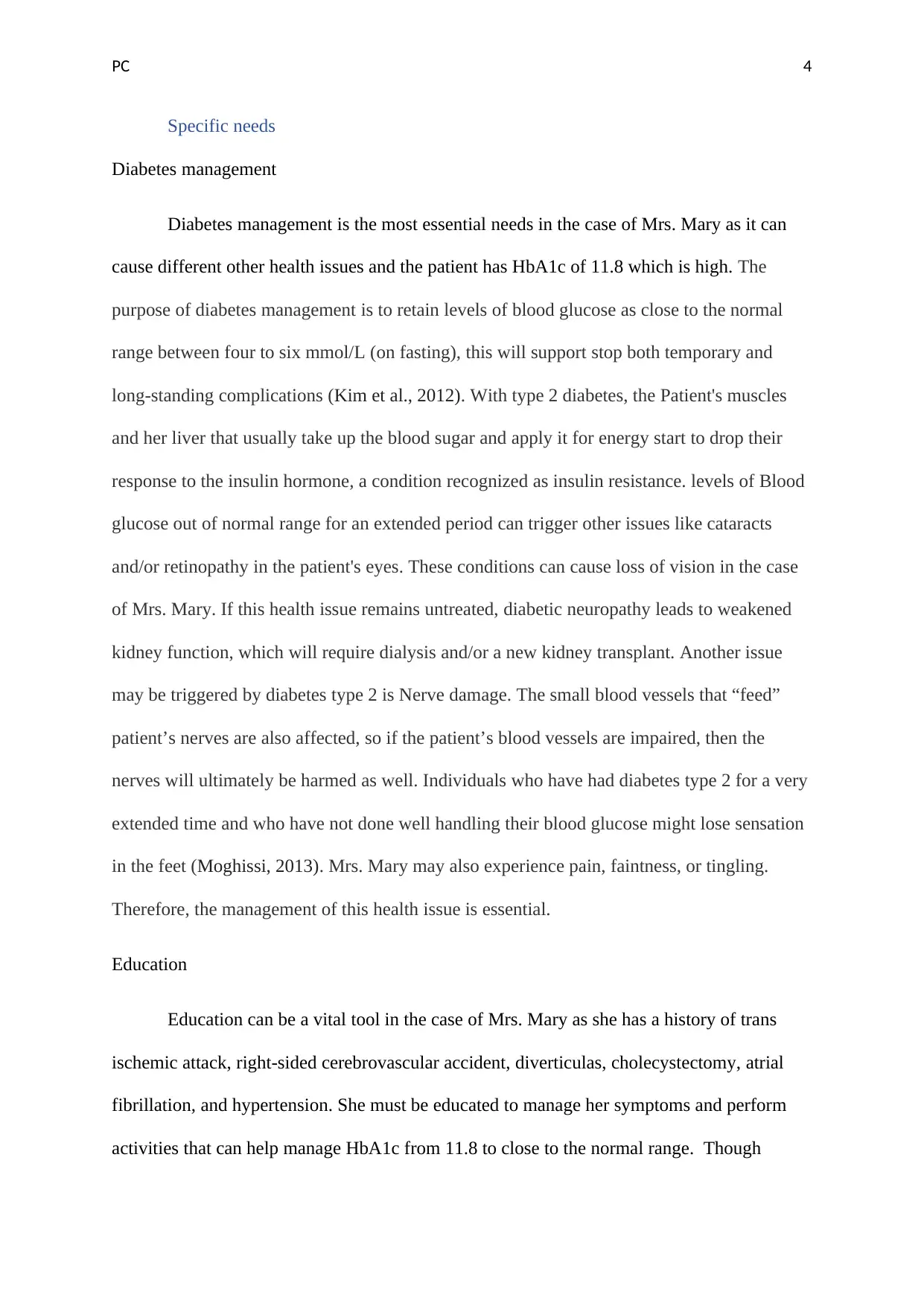
PC 4
Specific needs
Diabetes management
Diabetes management is the most essential needs in the case of Mrs. Mary as it can
cause different other health issues and the patient has HbA1c of 11.8 which is high. The
purpose of diabetes management is to retain levels of blood glucose as close to the normal
range between four to six mmol/L (on fasting), this will support stop both temporary and
long-standing complications (Kim et al., 2012). With type 2 diabetes, the Patient's muscles
and her liver that usually take up the blood sugar and apply it for energy start to drop their
response to the insulin hormone, a condition recognized as insulin resistance. levels of Blood
glucose out of normal range for an extended period can trigger other issues like cataracts
and/or retinopathy in the patient's eyes. These conditions can cause loss of vision in the case
of Mrs. Mary. If this health issue remains untreated, diabetic neuropathy leads to weakened
kidney function, which will require dialysis and/or a new kidney transplant. Another issue
may be triggered by diabetes type 2 is Nerve damage. The small blood vessels that “feed”
patient’s nerves are also affected, so if the patient’s blood vessels are impaired, then the
nerves will ultimately be harmed as well. Individuals who have had diabetes type 2 for a very
extended time and who have not done well handling their blood glucose might lose sensation
in the feet (Moghissi, 2013). Mrs. Mary may also experience pain, faintness, or tingling.
Therefore, the management of this health issue is essential.
Education
Education can be a vital tool in the case of Mrs. Mary as she has a history of trans
ischemic attack, right-sided cerebrovascular accident, diverticulas, cholecystectomy, atrial
fibrillation, and hypertension. She must be educated to manage her symptoms and perform
activities that can help manage HbA1c from 11.8 to close to the normal range. Though
Specific needs
Diabetes management
Diabetes management is the most essential needs in the case of Mrs. Mary as it can
cause different other health issues and the patient has HbA1c of 11.8 which is high. The
purpose of diabetes management is to retain levels of blood glucose as close to the normal
range between four to six mmol/L (on fasting), this will support stop both temporary and
long-standing complications (Kim et al., 2012). With type 2 diabetes, the Patient's muscles
and her liver that usually take up the blood sugar and apply it for energy start to drop their
response to the insulin hormone, a condition recognized as insulin resistance. levels of Blood
glucose out of normal range for an extended period can trigger other issues like cataracts
and/or retinopathy in the patient's eyes. These conditions can cause loss of vision in the case
of Mrs. Mary. If this health issue remains untreated, diabetic neuropathy leads to weakened
kidney function, which will require dialysis and/or a new kidney transplant. Another issue
may be triggered by diabetes type 2 is Nerve damage. The small blood vessels that “feed”
patient’s nerves are also affected, so if the patient’s blood vessels are impaired, then the
nerves will ultimately be harmed as well. Individuals who have had diabetes type 2 for a very
extended time and who have not done well handling their blood glucose might lose sensation
in the feet (Moghissi, 2013). Mrs. Mary may also experience pain, faintness, or tingling.
Therefore, the management of this health issue is essential.
Education
Education can be a vital tool in the case of Mrs. Mary as she has a history of trans
ischemic attack, right-sided cerebrovascular accident, diverticulas, cholecystectomy, atrial
fibrillation, and hypertension. She must be educated to manage her symptoms and perform
activities that can help manage HbA1c from 11.8 to close to the normal range. Though
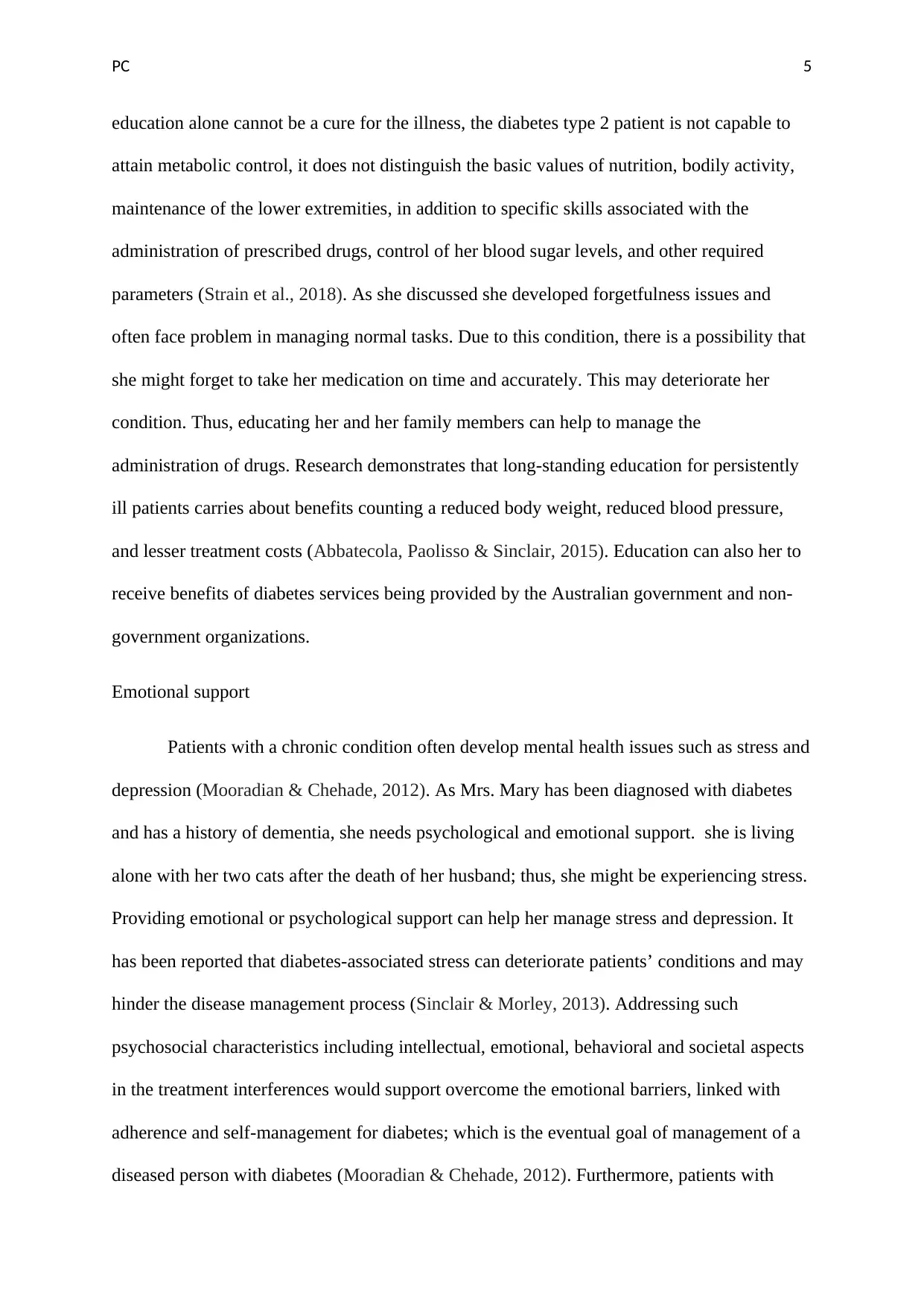
PC 5
education alone cannot be a cure for the illness, the diabetes type 2 patient is not capable to
attain metabolic control, it does not distinguish the basic values of nutrition, bodily activity,
maintenance of the lower extremities, in addition to specific skills associated with the
administration of prescribed drugs, control of her blood sugar levels, and other required
parameters (Strain et al., 2018). As she discussed she developed forgetfulness issues and
often face problem in managing normal tasks. Due to this condition, there is a possibility that
she might forget to take her medication on time and accurately. This may deteriorate her
condition. Thus, educating her and her family members can help to manage the
administration of drugs. Research demonstrates that long-standing education for persistently
ill patients carries about benefits counting a reduced body weight, reduced blood pressure,
and lesser treatment costs (Abbatecola, Paolisso & Sinclair, 2015). Education can also her to
receive benefits of diabetes services being provided by the Australian government and non-
government organizations.
Emotional support
Patients with a chronic condition often develop mental health issues such as stress and
depression (Mooradian & Chehade, 2012). As Mrs. Mary has been diagnosed with diabetes
and has a history of dementia, she needs psychological and emotional support. she is living
alone with her two cats after the death of her husband; thus, she might be experiencing stress.
Providing emotional or psychological support can help her manage stress and depression. It
has been reported that diabetes-associated stress can deteriorate patients’ conditions and may
hinder the disease management process (Sinclair & Morley, 2013). Addressing such
psychosocial characteristics including intellectual, emotional, behavioral and societal aspects
in the treatment interferences would support overcome the emotional barriers, linked with
adherence and self-management for diabetes; which is the eventual goal of management of a
diseased person with diabetes (Mooradian & Chehade, 2012). Furthermore, patients with
education alone cannot be a cure for the illness, the diabetes type 2 patient is not capable to
attain metabolic control, it does not distinguish the basic values of nutrition, bodily activity,
maintenance of the lower extremities, in addition to specific skills associated with the
administration of prescribed drugs, control of her blood sugar levels, and other required
parameters (Strain et al., 2018). As she discussed she developed forgetfulness issues and
often face problem in managing normal tasks. Due to this condition, there is a possibility that
she might forget to take her medication on time and accurately. This may deteriorate her
condition. Thus, educating her and her family members can help to manage the
administration of drugs. Research demonstrates that long-standing education for persistently
ill patients carries about benefits counting a reduced body weight, reduced blood pressure,
and lesser treatment costs (Abbatecola, Paolisso & Sinclair, 2015). Education can also her to
receive benefits of diabetes services being provided by the Australian government and non-
government organizations.
Emotional support
Patients with a chronic condition often develop mental health issues such as stress and
depression (Mooradian & Chehade, 2012). As Mrs. Mary has been diagnosed with diabetes
and has a history of dementia, she needs psychological and emotional support. she is living
alone with her two cats after the death of her husband; thus, she might be experiencing stress.
Providing emotional or psychological support can help her manage stress and depression. It
has been reported that diabetes-associated stress can deteriorate patients’ conditions and may
hinder the disease management process (Sinclair & Morley, 2013). Addressing such
psychosocial characteristics including intellectual, emotional, behavioral and societal aspects
in the treatment interferences would support overcome the emotional barriers, linked with
adherence and self-management for diabetes; which is the eventual goal of management of a
diseased person with diabetes (Mooradian & Chehade, 2012). Furthermore, patients with
⊘ This is a preview!⊘
Do you want full access?
Subscribe today to unlock all pages.

Trusted by 1+ million students worldwide
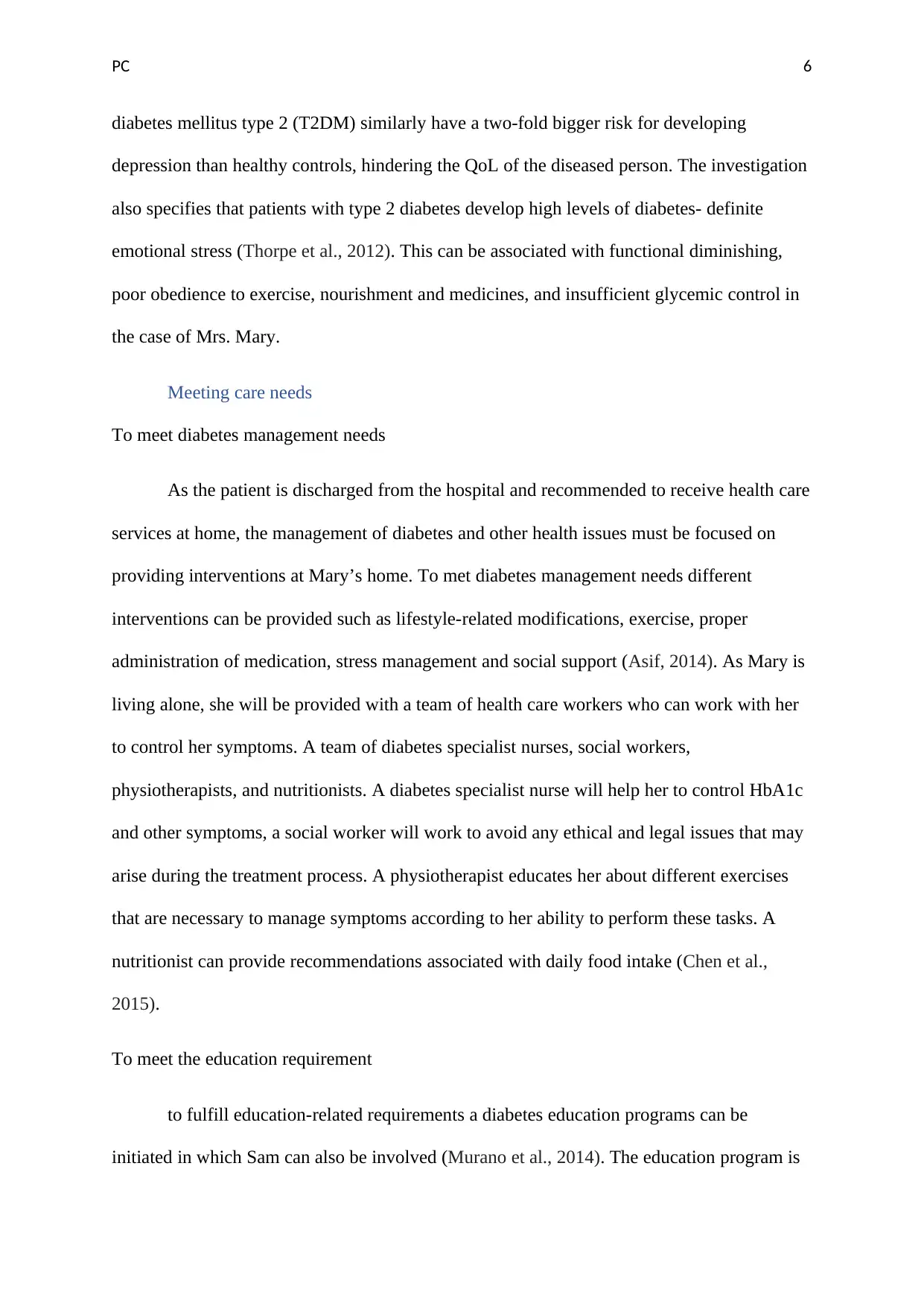
PC 6
diabetes mellitus type 2 (T2DM) similarly have a two-fold bigger risk for developing
depression than healthy controls, hindering the QoL of the diseased person. The investigation
also specifies that patients with type 2 diabetes develop high levels of diabetes- definite
emotional stress (Thorpe et al., 2012). This can be associated with functional diminishing,
poor obedience to exercise, nourishment and medicines, and insufficient glycemic control in
the case of Mrs. Mary.
Meeting care needs
To meet diabetes management needs
As the patient is discharged from the hospital and recommended to receive health care
services at home, the management of diabetes and other health issues must be focused on
providing interventions at Mary’s home. To met diabetes management needs different
interventions can be provided such as lifestyle-related modifications, exercise, proper
administration of medication, stress management and social support (Asif, 2014). As Mary is
living alone, she will be provided with a team of health care workers who can work with her
to control her symptoms. A team of diabetes specialist nurses, social workers,
physiotherapists, and nutritionists. A diabetes specialist nurse will help her to control HbA1c
and other symptoms, a social worker will work to avoid any ethical and legal issues that may
arise during the treatment process. A physiotherapist educates her about different exercises
that are necessary to manage symptoms according to her ability to perform these tasks. A
nutritionist can provide recommendations associated with daily food intake (Chen et al.,
2015).
To meet the education requirement
to fulfill education-related requirements a diabetes education programs can be
initiated in which Sam can also be involved (Murano et al., 2014). The education program is
diabetes mellitus type 2 (T2DM) similarly have a two-fold bigger risk for developing
depression than healthy controls, hindering the QoL of the diseased person. The investigation
also specifies that patients with type 2 diabetes develop high levels of diabetes- definite
emotional stress (Thorpe et al., 2012). This can be associated with functional diminishing,
poor obedience to exercise, nourishment and medicines, and insufficient glycemic control in
the case of Mrs. Mary.
Meeting care needs
To meet diabetes management needs
As the patient is discharged from the hospital and recommended to receive health care
services at home, the management of diabetes and other health issues must be focused on
providing interventions at Mary’s home. To met diabetes management needs different
interventions can be provided such as lifestyle-related modifications, exercise, proper
administration of medication, stress management and social support (Asif, 2014). As Mary is
living alone, she will be provided with a team of health care workers who can work with her
to control her symptoms. A team of diabetes specialist nurses, social workers,
physiotherapists, and nutritionists. A diabetes specialist nurse will help her to control HbA1c
and other symptoms, a social worker will work to avoid any ethical and legal issues that may
arise during the treatment process. A physiotherapist educates her about different exercises
that are necessary to manage symptoms according to her ability to perform these tasks. A
nutritionist can provide recommendations associated with daily food intake (Chen et al.,
2015).
To meet the education requirement
to fulfill education-related requirements a diabetes education programs can be
initiated in which Sam can also be involved (Murano et al., 2014). The education program is
Paraphrase This Document
Need a fresh take? Get an instant paraphrase of this document with our AI Paraphraser
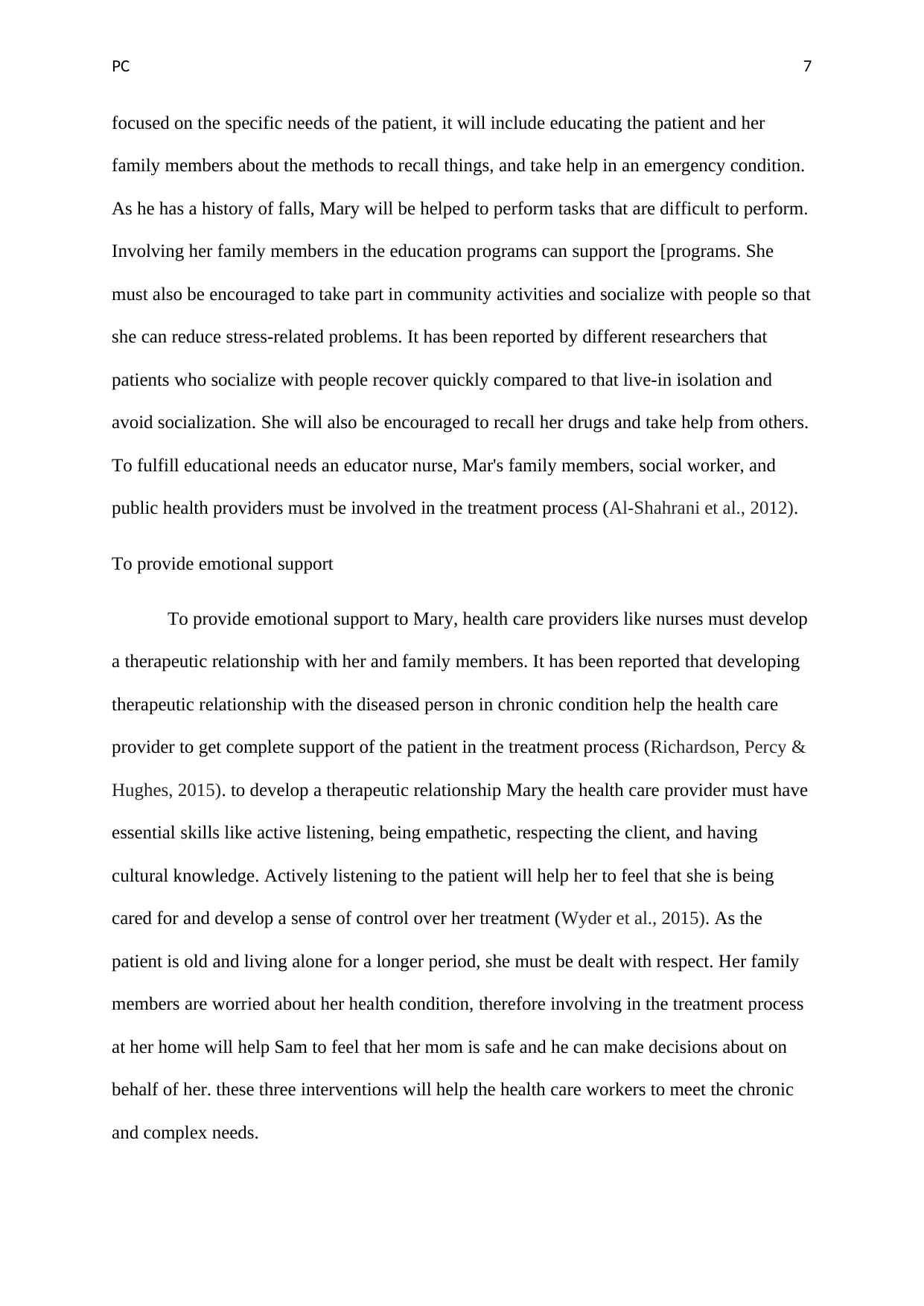
PC 7
focused on the specific needs of the patient, it will include educating the patient and her
family members about the methods to recall things, and take help in an emergency condition.
As he has a history of falls, Mary will be helped to perform tasks that are difficult to perform.
Involving her family members in the education programs can support the [programs. She
must also be encouraged to take part in community activities and socialize with people so that
she can reduce stress-related problems. It has been reported by different researchers that
patients who socialize with people recover quickly compared to that live-in isolation and
avoid socialization. She will also be encouraged to recall her drugs and take help from others.
To fulfill educational needs an educator nurse, Mar's family members, social worker, and
public health providers must be involved in the treatment process (Al-Shahrani et al., 2012).
To provide emotional support
To provide emotional support to Mary, health care providers like nurses must develop
a therapeutic relationship with her and family members. It has been reported that developing
therapeutic relationship with the diseased person in chronic condition help the health care
provider to get complete support of the patient in the treatment process (Richardson, Percy &
Hughes, 2015). to develop a therapeutic relationship Mary the health care provider must have
essential skills like active listening, being empathetic, respecting the client, and having
cultural knowledge. Actively listening to the patient will help her to feel that she is being
cared for and develop a sense of control over her treatment (Wyder et al., 2015). As the
patient is old and living alone for a longer period, she must be dealt with respect. Her family
members are worried about her health condition, therefore involving in the treatment process
at her home will help Sam to feel that her mom is safe and he can make decisions about on
behalf of her. these three interventions will help the health care workers to meet the chronic
and complex needs.
focused on the specific needs of the patient, it will include educating the patient and her
family members about the methods to recall things, and take help in an emergency condition.
As he has a history of falls, Mary will be helped to perform tasks that are difficult to perform.
Involving her family members in the education programs can support the [programs. She
must also be encouraged to take part in community activities and socialize with people so that
she can reduce stress-related problems. It has been reported by different researchers that
patients who socialize with people recover quickly compared to that live-in isolation and
avoid socialization. She will also be encouraged to recall her drugs and take help from others.
To fulfill educational needs an educator nurse, Mar's family members, social worker, and
public health providers must be involved in the treatment process (Al-Shahrani et al., 2012).
To provide emotional support
To provide emotional support to Mary, health care providers like nurses must develop
a therapeutic relationship with her and family members. It has been reported that developing
therapeutic relationship with the diseased person in chronic condition help the health care
provider to get complete support of the patient in the treatment process (Richardson, Percy &
Hughes, 2015). to develop a therapeutic relationship Mary the health care provider must have
essential skills like active listening, being empathetic, respecting the client, and having
cultural knowledge. Actively listening to the patient will help her to feel that she is being
cared for and develop a sense of control over her treatment (Wyder et al., 2015). As the
patient is old and living alone for a longer period, she must be dealt with respect. Her family
members are worried about her health condition, therefore involving in the treatment process
at her home will help Sam to feel that her mom is safe and he can make decisions about on
behalf of her. these three interventions will help the health care workers to meet the chronic
and complex needs.
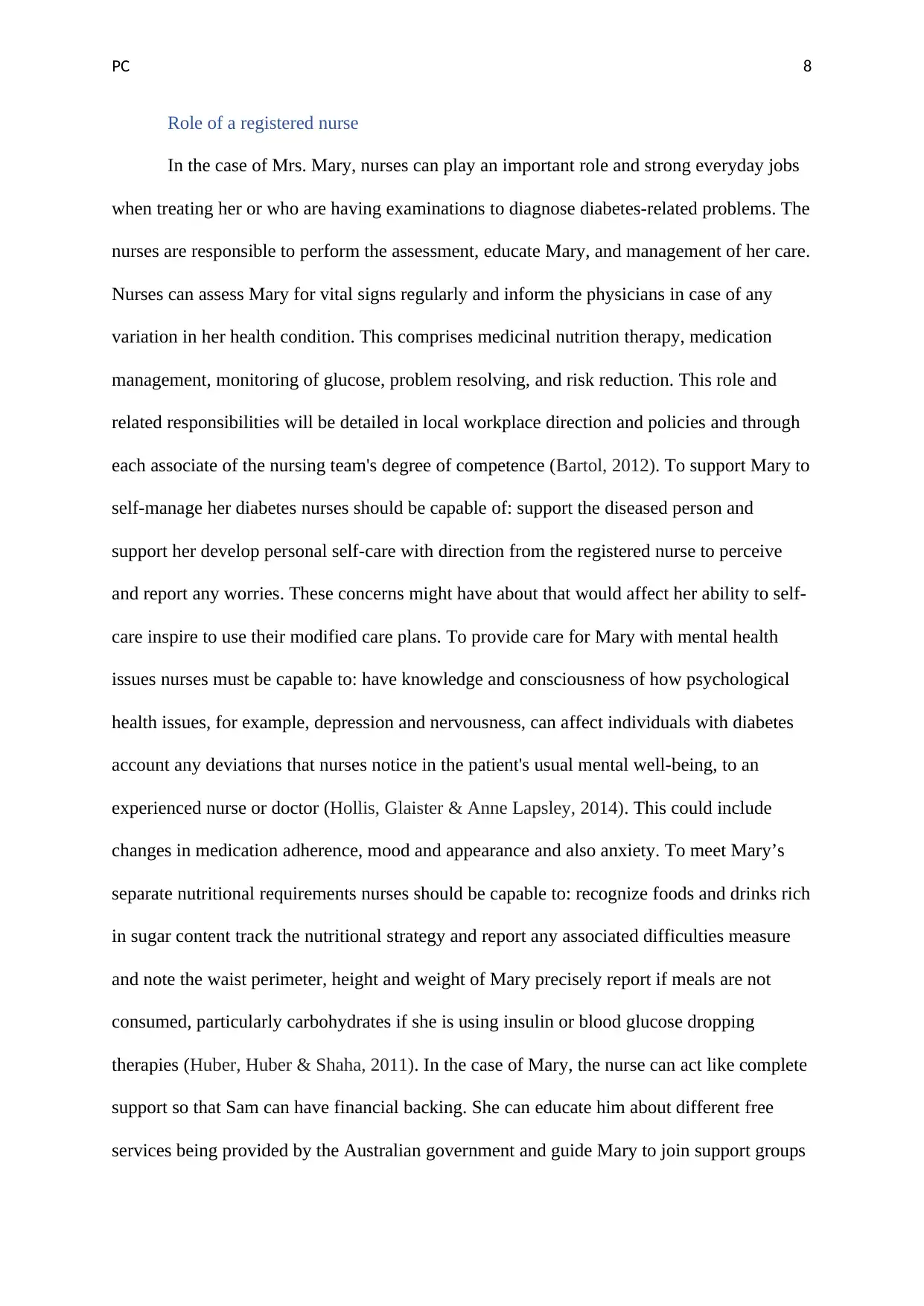
PC 8
Role of a registered nurse
In the case of Mrs. Mary, nurses can play an important role and strong everyday jobs
when treating her or who are having examinations to diagnose diabetes-related problems. The
nurses are responsible to perform the assessment, educate Mary, and management of her care.
Nurses can assess Mary for vital signs regularly and inform the physicians in case of any
variation in her health condition. This comprises medicinal nutrition therapy, medication
management, monitoring of glucose, problem resolving, and risk reduction. This role and
related responsibilities will be detailed in local workplace direction and policies and through
each associate of the nursing team's degree of competence (Bartol, 2012). To support Mary to
self-manage her diabetes nurses should be capable of: support the diseased person and
support her develop personal self-care with direction from the registered nurse to perceive
and report any worries. These concerns might have about that would affect her ability to self-
care inspire to use their modified care plans. To provide care for Mary with mental health
issues nurses must be capable to: have knowledge and consciousness of how psychological
health issues, for example, depression and nervousness, can affect individuals with diabetes
account any deviations that nurses notice in the patient's usual mental well-being, to an
experienced nurse or doctor (Hollis, Glaister & Anne Lapsley, 2014). This could include
changes in medication adherence, mood and appearance and also anxiety. To meet Mary’s
separate nutritional requirements nurses should be capable to: recognize foods and drinks rich
in sugar content track the nutritional strategy and report any associated difficulties measure
and note the waist perimeter, height and weight of Mary precisely report if meals are not
consumed, particularly carbohydrates if she is using insulin or blood glucose dropping
therapies (Huber, Huber & Shaha, 2011). In the case of Mary, the nurse can act like complete
support so that Sam can have financial backing. She can educate him about different free
services being provided by the Australian government and guide Mary to join support groups
Role of a registered nurse
In the case of Mrs. Mary, nurses can play an important role and strong everyday jobs
when treating her or who are having examinations to diagnose diabetes-related problems. The
nurses are responsible to perform the assessment, educate Mary, and management of her care.
Nurses can assess Mary for vital signs regularly and inform the physicians in case of any
variation in her health condition. This comprises medicinal nutrition therapy, medication
management, monitoring of glucose, problem resolving, and risk reduction. This role and
related responsibilities will be detailed in local workplace direction and policies and through
each associate of the nursing team's degree of competence (Bartol, 2012). To support Mary to
self-manage her diabetes nurses should be capable of: support the diseased person and
support her develop personal self-care with direction from the registered nurse to perceive
and report any worries. These concerns might have about that would affect her ability to self-
care inspire to use their modified care plans. To provide care for Mary with mental health
issues nurses must be capable to: have knowledge and consciousness of how psychological
health issues, for example, depression and nervousness, can affect individuals with diabetes
account any deviations that nurses notice in the patient's usual mental well-being, to an
experienced nurse or doctor (Hollis, Glaister & Anne Lapsley, 2014). This could include
changes in medication adherence, mood and appearance and also anxiety. To meet Mary’s
separate nutritional requirements nurses should be capable to: recognize foods and drinks rich
in sugar content track the nutritional strategy and report any associated difficulties measure
and note the waist perimeter, height and weight of Mary precisely report if meals are not
consumed, particularly carbohydrates if she is using insulin or blood glucose dropping
therapies (Huber, Huber & Shaha, 2011). In the case of Mary, the nurse can act like complete
support so that Sam can have financial backing. She can educate him about different free
services being provided by the Australian government and guide Mary to join support groups
⊘ This is a preview!⊘
Do you want full access?
Subscribe today to unlock all pages.

Trusted by 1+ million students worldwide
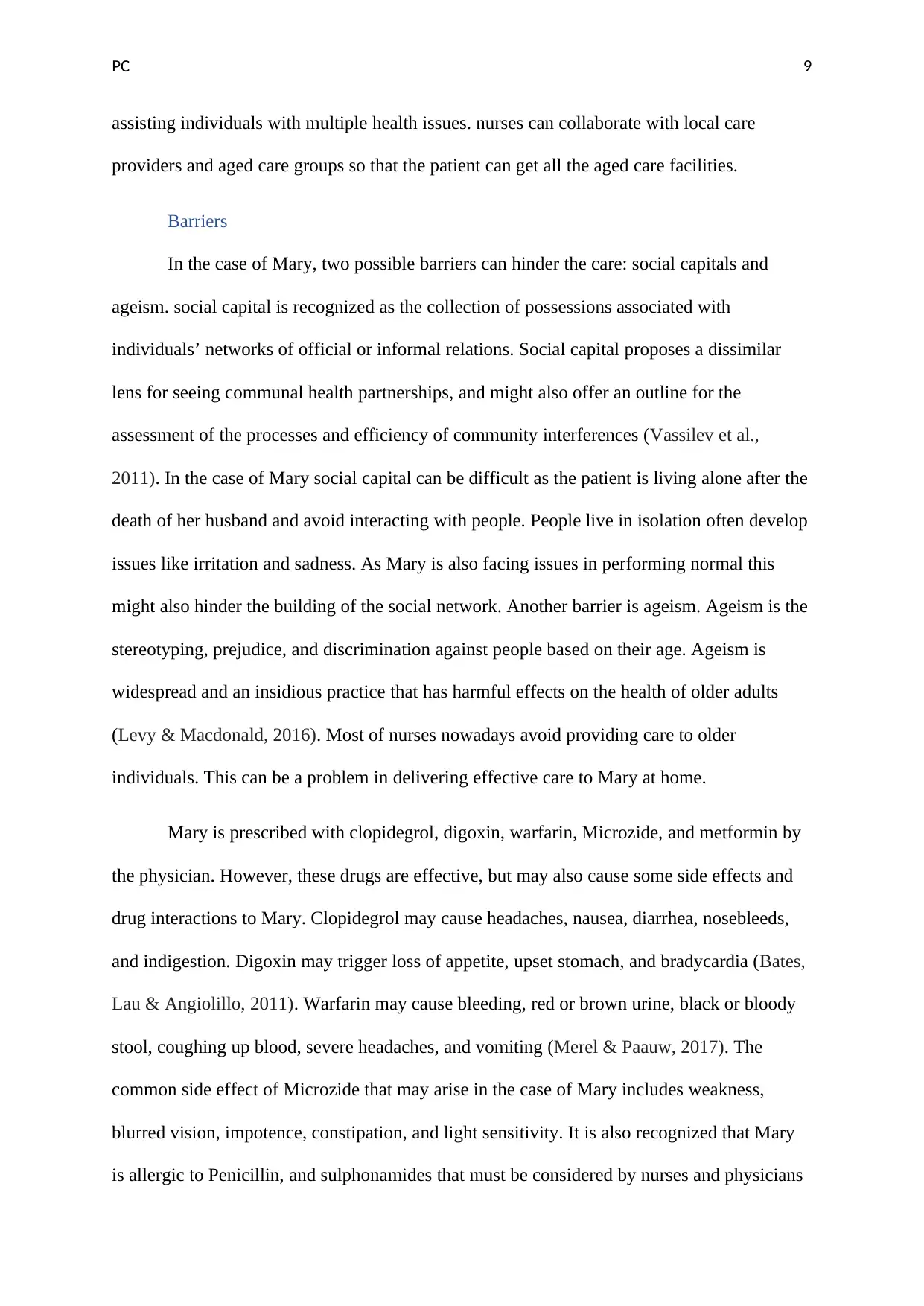
PC 9
assisting individuals with multiple health issues. nurses can collaborate with local care
providers and aged care groups so that the patient can get all the aged care facilities.
Barriers
In the case of Mary, two possible barriers can hinder the care: social capitals and
ageism. social capital is recognized as the collection of possessions associated with
individuals’ networks of official or informal relations. Social capital proposes a dissimilar
lens for seeing communal health partnerships, and might also offer an outline for the
assessment of the processes and efficiency of community interferences (Vassilev et al.,
2011). In the case of Mary social capital can be difficult as the patient is living alone after the
death of her husband and avoid interacting with people. People live in isolation often develop
issues like irritation and sadness. As Mary is also facing issues in performing normal this
might also hinder the building of the social network. Another barrier is ageism. Ageism is the
stereotyping, prejudice, and discrimination against people based on their age. Ageism is
widespread and an insidious practice that has harmful effects on the health of older adults
(Levy & Macdonald, 2016). Most of nurses nowadays avoid providing care to older
individuals. This can be a problem in delivering effective care to Mary at home.
Mary is prescribed with clopidegrol, digoxin, warfarin, Microzide, and metformin by
the physician. However, these drugs are effective, but may also cause some side effects and
drug interactions to Mary. Clopidegrol may cause headaches, nausea, diarrhea, nosebleeds,
and indigestion. Digoxin may trigger loss of appetite, upset stomach, and bradycardia (Bates,
Lau & Angiolillo, 2011). Warfarin may cause bleeding, red or brown urine, black or bloody
stool, coughing up blood, severe headaches, and vomiting (Merel & Paauw, 2017). The
common side effect of Microzide that may arise in the case of Mary includes weakness,
blurred vision, impotence, constipation, and light sensitivity. It is also recognized that Mary
is allergic to Penicillin, and sulphonamides that must be considered by nurses and physicians
assisting individuals with multiple health issues. nurses can collaborate with local care
providers and aged care groups so that the patient can get all the aged care facilities.
Barriers
In the case of Mary, two possible barriers can hinder the care: social capitals and
ageism. social capital is recognized as the collection of possessions associated with
individuals’ networks of official or informal relations. Social capital proposes a dissimilar
lens for seeing communal health partnerships, and might also offer an outline for the
assessment of the processes and efficiency of community interferences (Vassilev et al.,
2011). In the case of Mary social capital can be difficult as the patient is living alone after the
death of her husband and avoid interacting with people. People live in isolation often develop
issues like irritation and sadness. As Mary is also facing issues in performing normal this
might also hinder the building of the social network. Another barrier is ageism. Ageism is the
stereotyping, prejudice, and discrimination against people based on their age. Ageism is
widespread and an insidious practice that has harmful effects on the health of older adults
(Levy & Macdonald, 2016). Most of nurses nowadays avoid providing care to older
individuals. This can be a problem in delivering effective care to Mary at home.
Mary is prescribed with clopidegrol, digoxin, warfarin, Microzide, and metformin by
the physician. However, these drugs are effective, but may also cause some side effects and
drug interactions to Mary. Clopidegrol may cause headaches, nausea, diarrhea, nosebleeds,
and indigestion. Digoxin may trigger loss of appetite, upset stomach, and bradycardia (Bates,
Lau & Angiolillo, 2011). Warfarin may cause bleeding, red or brown urine, black or bloody
stool, coughing up blood, severe headaches, and vomiting (Merel & Paauw, 2017). The
common side effect of Microzide that may arise in the case of Mary includes weakness,
blurred vision, impotence, constipation, and light sensitivity. It is also recognized that Mary
is allergic to Penicillin, and sulphonamides that must be considered by nurses and physicians
Paraphrase This Document
Need a fresh take? Get an instant paraphrase of this document with our AI Paraphraser
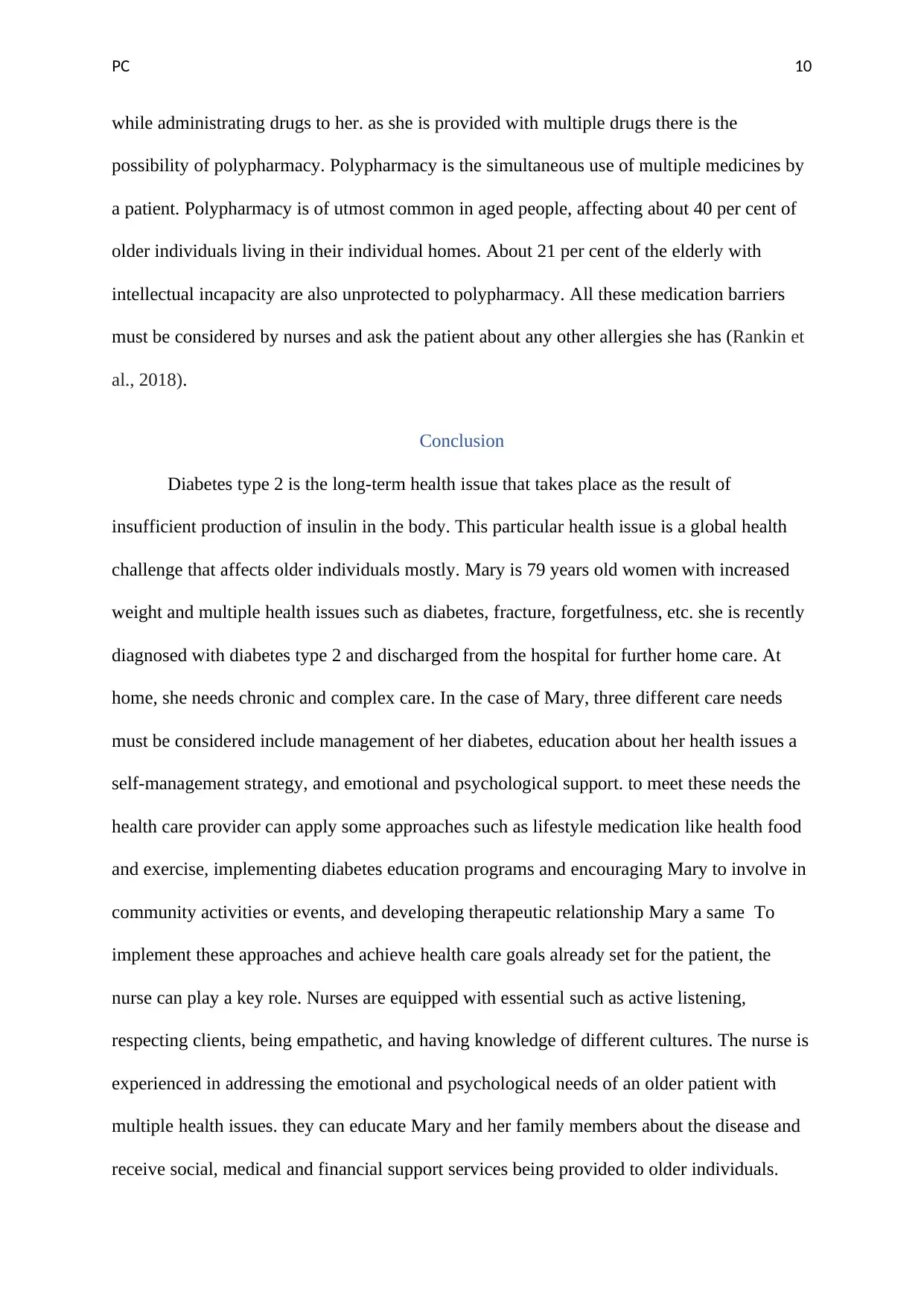
PC 10
while administrating drugs to her. as she is provided with multiple drugs there is the
possibility of polypharmacy. Polypharmacy is the simultaneous use of multiple medicines by
a patient. Polypharmacy is of utmost common in aged people, affecting about 40 per cent of
older individuals living in their individual homes. About 21 per cent of the elderly with
intellectual incapacity are also unprotected to polypharmacy. All these medication barriers
must be considered by nurses and ask the patient about any other allergies she has (Rankin et
al., 2018).
Conclusion
Diabetes type 2 is the long-term health issue that takes place as the result of
insufficient production of insulin in the body. This particular health issue is a global health
challenge that affects older individuals mostly. Mary is 79 years old women with increased
weight and multiple health issues such as diabetes, fracture, forgetfulness, etc. she is recently
diagnosed with diabetes type 2 and discharged from the hospital for further home care. At
home, she needs chronic and complex care. In the case of Mary, three different care needs
must be considered include management of her diabetes, education about her health issues a
self-management strategy, and emotional and psychological support. to meet these needs the
health care provider can apply some approaches such as lifestyle medication like health food
and exercise, implementing diabetes education programs and encouraging Mary to involve in
community activities or events, and developing therapeutic relationship Mary a same To
implement these approaches and achieve health care goals already set for the patient, the
nurse can play a key role. Nurses are equipped with essential such as active listening,
respecting clients, being empathetic, and having knowledge of different cultures. The nurse is
experienced in addressing the emotional and psychological needs of an older patient with
multiple health issues. they can educate Mary and her family members about the disease and
receive social, medical and financial support services being provided to older individuals.
while administrating drugs to her. as she is provided with multiple drugs there is the
possibility of polypharmacy. Polypharmacy is the simultaneous use of multiple medicines by
a patient. Polypharmacy is of utmost common in aged people, affecting about 40 per cent of
older individuals living in their individual homes. About 21 per cent of the elderly with
intellectual incapacity are also unprotected to polypharmacy. All these medication barriers
must be considered by nurses and ask the patient about any other allergies she has (Rankin et
al., 2018).
Conclusion
Diabetes type 2 is the long-term health issue that takes place as the result of
insufficient production of insulin in the body. This particular health issue is a global health
challenge that affects older individuals mostly. Mary is 79 years old women with increased
weight and multiple health issues such as diabetes, fracture, forgetfulness, etc. she is recently
diagnosed with diabetes type 2 and discharged from the hospital for further home care. At
home, she needs chronic and complex care. In the case of Mary, three different care needs
must be considered include management of her diabetes, education about her health issues a
self-management strategy, and emotional and psychological support. to meet these needs the
health care provider can apply some approaches such as lifestyle medication like health food
and exercise, implementing diabetes education programs and encouraging Mary to involve in
community activities or events, and developing therapeutic relationship Mary a same To
implement these approaches and achieve health care goals already set for the patient, the
nurse can play a key role. Nurses are equipped with essential such as active listening,
respecting clients, being empathetic, and having knowledge of different cultures. The nurse is
experienced in addressing the emotional and psychological needs of an older patient with
multiple health issues. they can educate Mary and her family members about the disease and
receive social, medical and financial support services being provided to older individuals.
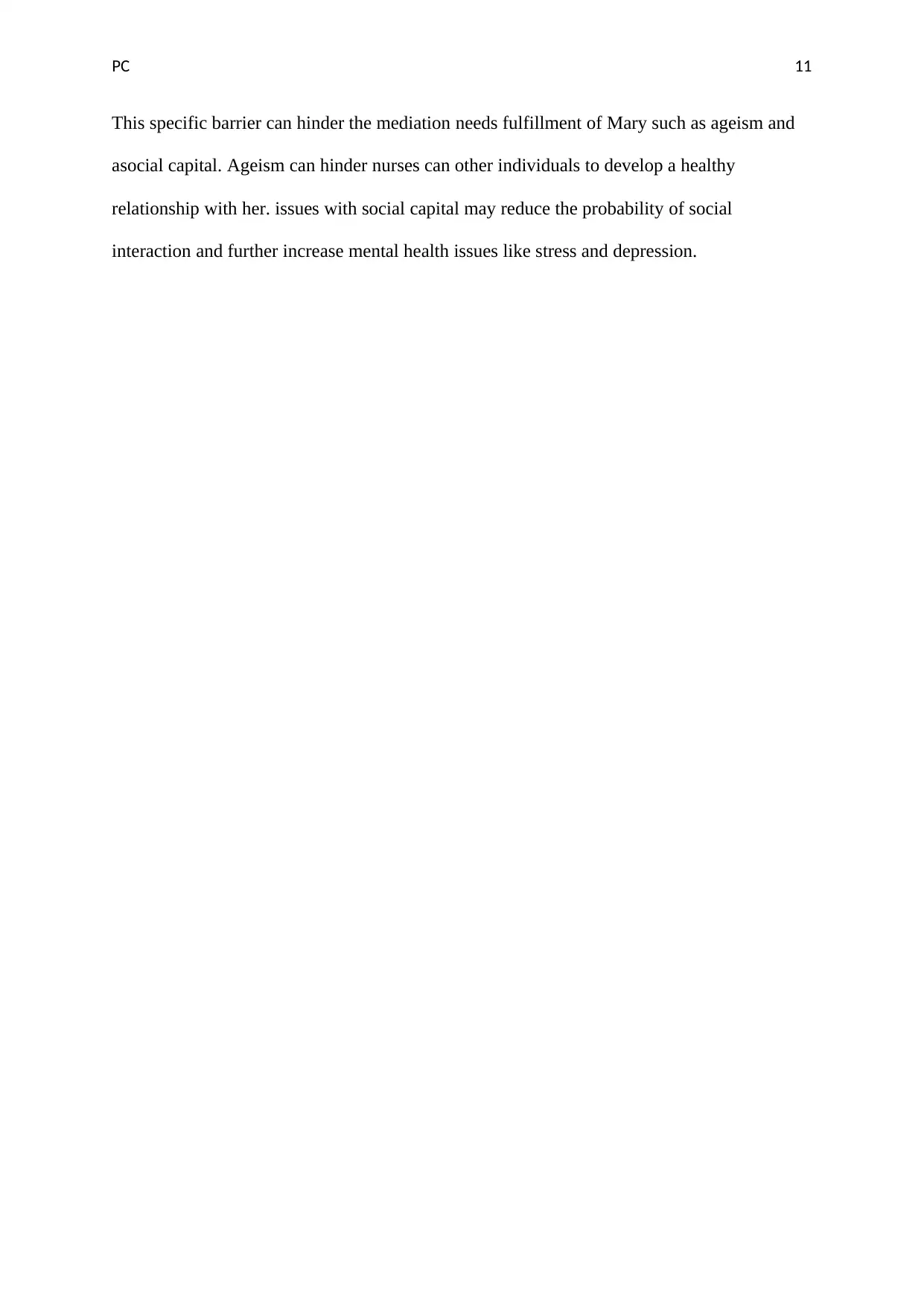
PC 11
This specific barrier can hinder the mediation needs fulfillment of Mary such as ageism and
asocial capital. Ageism can hinder nurses can other individuals to develop a healthy
relationship with her. issues with social capital may reduce the probability of social
interaction and further increase mental health issues like stress and depression.
This specific barrier can hinder the mediation needs fulfillment of Mary such as ageism and
asocial capital. Ageism can hinder nurses can other individuals to develop a healthy
relationship with her. issues with social capital may reduce the probability of social
interaction and further increase mental health issues like stress and depression.
⊘ This is a preview!⊘
Do you want full access?
Subscribe today to unlock all pages.

Trusted by 1+ million students worldwide
1 out of 17
Related Documents
Your All-in-One AI-Powered Toolkit for Academic Success.
+13062052269
info@desklib.com
Available 24*7 on WhatsApp / Email
![[object Object]](/_next/static/media/star-bottom.7253800d.svg)
Unlock your academic potential
Copyright © 2020–2025 A2Z Services. All Rights Reserved. Developed and managed by ZUCOL.





